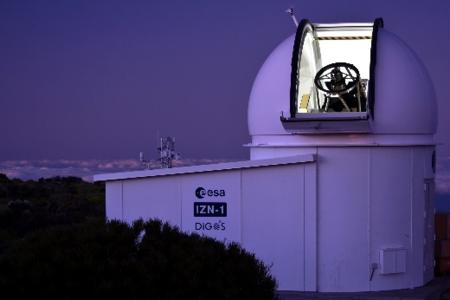Laser Ranging Station (LRS) for Cooperative Targets
Programme
GSTP
Programme Reference
G618-050GS
Prime Contractor
DiGOS Potsdam GmbH
Start Date
End Date
Status
Closed
Country
Germany

Objectives
The objective is the Development, Integration, and Validation of ESA's first Laser Ranging Station (LRS) Prototype that will range cooperative space objects (having on-board retro-reflectors), and will provide the basis for further steps leading to ranging of non-cooperative space objects (such as space debris).
The ESA Laser Ranging capability will allow to
- support future Space Traffic Management applications (collision avoidance, ;re-entry prediction, contingencies) and other missions (spacecraft fine positioning, electric propulsion monitoring from GTO to GEO, GNSS orbit calibration, precise orbit monitoring for science gravitometry, emergency spacecraft support),
- assume ESA's role in advancing critical optical sensor technology developments by providing a technical reference to the European laser ranging community and support industry in maturing commercial products,
- facilitate the move towards ranging to non-cooperative targets during both day amp; night as well as to fully automated operation,
- contribute into the space object tracking cataloguing and the ILRS community
Description
The activity plans the following tasks:
Development, Integration and Validation of:
- a Receive Telescope with a 80cm aperture mounted on a very precise Mount with arcsecond pointing and tracking accuracy
- a Transmit Laser Package (precise pulsed source capable to operate at 532nm and 1064nm)
- a time-gated photon-counting Detection Package (filters and detectors sensitive at 532nm and 1064nm)
- a precise Control, Timing, Calibration and Processing System as the central "heart" of the LRS
The LRS shall be capable
- of ranging to cooperative targets up to an altitude of at least 27'000km with millimeter precision
- of fully remote operation and future fully automated operation
- of future adaptation for ranging to non-cooperative targets
- of supporting additional receive equipment for optical communications
The overall activity budget is 1,600K€, of which the GSTP technology development content correspond to 500K€.
Application Domain
Space Safety
Technology Domain
11 - Space Debris
12 - Ground Station Systems and Networks
Competence Domain
8-Ground Systems and Mission Operations
Keywords
1-Space Situational Awareness
Initial TRL
TRL 5
Target TRL
TRL 7
Achieved TRL
TRL 6
Public Document
Final Presentation
Executive Summary
